
Blog, Heel Pain
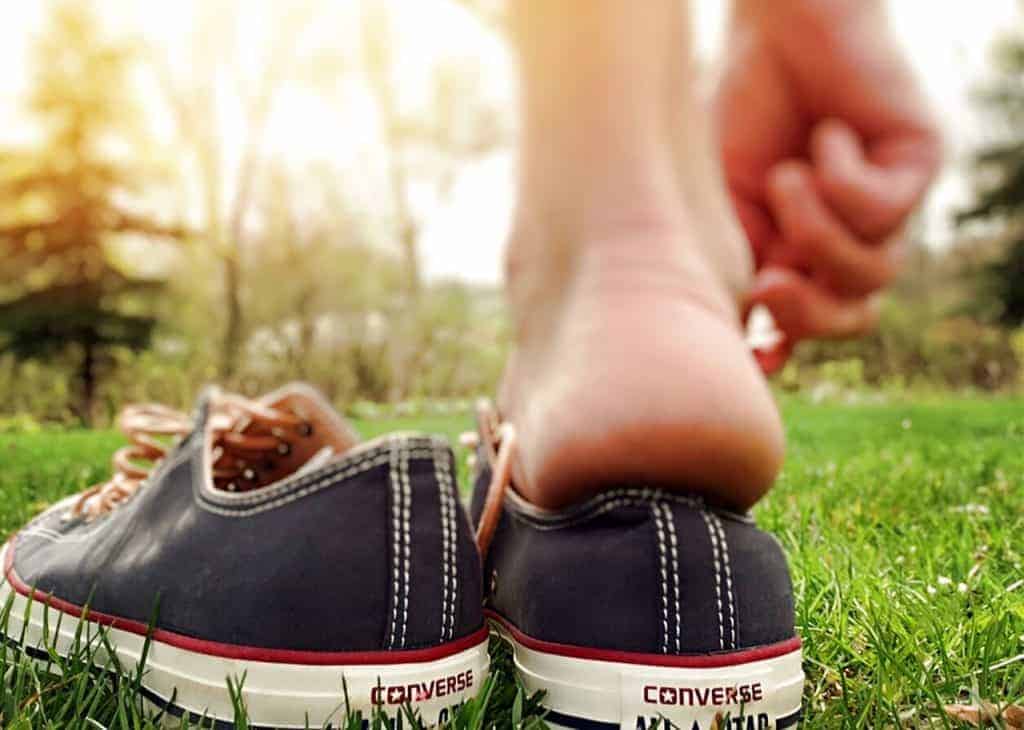
Think you have a heel spur? Think again
There’s a myriad mystery and misinformation about heel spurs. Just the thought alone of having a hard protruding growth on the bottom of the heel is more than a little alarming — but really, it needn’t be.
What is a heel spur?
“A heel spur is a small bony growth at the underside of the heel bone. People call it a spur or a calcification. We might also call it an exostosis (a benign outgrowth of cartilaginous tissue),” explains sports podiatrist and founder of A Step Ahead Foot + Ankle Care Dr Brenden Brown.
“Heel spurs are incredibly common. I see it in about 40-50% of the x-rays I perform. “However, the vast majority of people with heel spurs experience NO PAIN whatsoever.
“In all of the time I have been a podiatrist (which is 20 plus years) I have seen two symptomatic heel spurs. I’ve seen lots of heel spurs but only two that have ever presented with associated pain.
“So if we talk about the signs of symptoms of heel spurs there aren’t really any apart from having a large bony or hard nodule on the underside of the heel pad that doesn’t feel the same as the other foot and cannot be depressed (pushed or squashed).
“99% of people who come to me saying they have pain from a heel spur do not have pain as a result of a spur.
“A heel spur won’t bother you unless it’s prominent beneath your foot and the orientation of the spur is angled more towards the ground; this could cause some pain and discomfort. However, I’ve read about these types of spurs but I’ve never even seen one. Not in 20 years of practicing.”
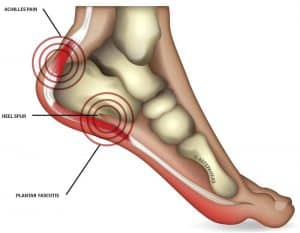
5 heel spur facts
- Your pain is most likely not caused by a heel spur
The vast array of people with heel spurs have NEVER HAD A DAY OF PAIN in their life
- Heel spur pain doesn’t come and go like a yo-yo
In those very rare cases where people do have a heel spur that’s causing them pain—the pain doesn’t come and go.
“If you have a friend who tells you they had a heel spur and the pain went away you have to ask yourself ‘where did that pain go?’ The pain of a heel spur isn’t like the cast of Neighbours – it doesn’t travel from Melbourne to Queensland to get a job and never return!”
- Silica won’t cure a heel spur
“People have told me they took silica and it miraculously dissolves their spur. I have to ask these patients ‘how on earth did the silica dissolve your bony spur but manage to leave the rest of the foot in tact. How did it not also dissolve the frontal lobe of your skull?”
- No operation needed
Even if you do have a heel spur, which most of the time is an incidental finding on an x-ray, you don’t need an operation to remove it.
- Cortisone won’t help your heel pain
For most people cortisone is useless in treating heel pain. In fact, studies have shown that after three months 56% of people who were having cortisone injections for their heel pain had zero reduction in pain.
If it’s not a heel spur — what is causing my pain?
Heel pain can be caused by a variety of other reasons including: plantar fasciitis, plantar fasciosis, abductor hallucis strain or tibialis posterior tendinosis.
If you are suffering from heel pain, be sure to visit your local podiatrist but don’t be fooled into automatically thinking that it’s a heel spur—it’s highly likely that it’s not!
Related articles:
10 things you should know about heel pain
A Step Ahead Foot + Ankle Care is one of Sydney’s leading foot and ankle clinics. Principal podiatrist and founder of A Step Ahead Dr Brenden Brown (AKA Dr Foot) has been taking care of people’s feet for more than 20 years.
With a background in sports medicine and having served as a former president of the Australasian Podiatry Council, Brenden is a wealth of information when it comes to foot and ankle care.
Got a question? Check out our Instagram profile #AskDrFoot
Or, tune into our Facebook page for regular live videos and updates on the latest foot and ankle advice from the experts.

Blog, Kids Feet, Uncategorized

Taking care of common kids’ foot complaints
While most parents worry about the health of their child’s eyes and teeth, many overlook the state of their kids’ feet. Feet are amazing; not only do they enable us to stand tall and move, they support our body weight and act as shock absorbers, in turn protecting our ankles, knees, hips and spine.
In young children the foot is pliable to allow it to develop, which means taking care of feet during the first few years of a child’s life is vital.
Recognising common foot complaints can help ensure that action is taken to address the problem and ensure your child’s feet continue to develop in a healthy way.

Ingrown toenails
Ingrown toenails are common with multiple causes. Widespread causes can include clipping the nails too short, cutting or picking at the edges of the nail, trauma to the nail due to kicking sports, excessively sweaty feet and pressure from footwear. All of these events can create a sharp edge on the nail, which can pierce the skin and lead to an ingrown toenail.
The symptoms of an ingrown toenail (onychocrytosis) can include a sore toe, pain at one side of the toenail and, in severe cases, a pus-filled discharge. In most cases it’s usually the big toe that’s affected.
Closed-toe shoes are likely to increase the intensity of the pain and, if left untreated, it’s common for the toenail to become infected making it difficult to walk and particularly painful to play sport.
To treat an ingrown toenail start by soaking the foot daily in warm, salty water, gently patting dry and applying a topical antiseptic. If possible, refrain from wearing enclosed shoes.
If the issue does not resolve within a couple of days it may require treatment by a podiatrist. This is a simple procedure that involves removing the small, sharp portion of nail causing the grief and dressing the nail to protect against infection. It usually takes minutes.
In acute cases nail surgery may be required.

Flat feet
In infants flat feet is common because they have a fat pad under the foot that hides the developing arch. By about the age of eight, the foot arch becomes apparent. Yet some children never develop an arch and this is called ‘flat feet’.
Flat feet or pronated feet (foot and ankle roll inwards) can be hereditary or due to muscle length and tone. In some instances the condition causes no pain or discomfort but in other cases flat feet or over pronated feet can cause pain in multiple areas of the body including the foot itself, shins, knees, lower back and Achilles tendons.
A podiatrist can help treat flat feet using orthotics, which hold the feet in their correct position and help relieve the associated pain. A detailed biomechanical analysis is conducted to diagnose which type of orthotics is best (there are many!).
In addition to orthotics, a podiatrist can advise on other measures that can be taken as part of a multi-pronged treatment plan. This may include stretching, strengthening exercises or deep connective tissue massage. Bare in mind that being overweight or wearing poor footwear can contribute to the symptoms of flat feet.
Plantar warts
Warts can be the bane of a parent’s life because they are so easy to contract, yet notoriously difficult to get rid of.
Often mistaken for corns, plantar warts appear as small (less than 5mm) rough, flat bumps on the bottom of the foot—usually on the underside of the toes, heel or forefoot. Some plantar warts have little black dots in the centre. This is caused by small blood vessels.
Warts are the result of a virus, so they are easily transferred to other children and adults and are particularly common in swimming pools, gyms, communal showers and other places that involve water, warmth and bare feet.
There’s a plethora of treatments for plantar warts but many are lengthy and not always successful. If over-the-counter non-prescription medicines don’t work, you can try a prescription medication such as salicylic acid or cryotherapy, which involves freezing the wart with liquid nitrogen.
Alternatively, your local podiatrist can use laser treatment or a small instrument to remove the wart. To prevent future plantar warts, avoid letting your child go barefoot in high-risk places such as public showers and outdoor swimming pools.
Want to know more about taking care of kids’ feet? Visit: mykidsfootdoctor.com.au.
Got a question? Ask Dr Foot
A Step Ahead Foot + Ankle Care is one of Sydney’s leading foot and ankle clinics. Principal podiatrist and founder of A Step Ahead Dr Brenden Brown (AKA Dr Foot) has been taking care of people’s feet for more than 20 years. With a background in sports medicine and having served as a former president of the Australasian Podiatry Council, Brenden is a wealth of information when it comes to foot and ankle care.
Related blogs:
Does your child need to see a podiatrist?
Are growing pains causing your child discomfort?
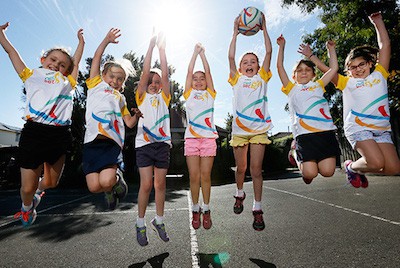
Blog, Sports Care

Your guide to choosing the best netball shoe
“The days of calling netball a non-contact sport are well and truly over,” says sports podiatrist and founder of A Step Ahead Foot + Ankle Care Dr Brenden Brown.
He says netball is not only physically demanding, it’s a high-impact sport in which foot and ankle injuries are rife (particularly if players aren’t wearing appropriate footwear!).
Do players really need new netball shoes every season?
Short answer is, ‘Yes, they do!’
“Netball involves lots of twisting on one foot, side to side motion, jumping and running—as a consequence, many players get ankle sprains. Having a new pair of shoes at the beginning of netball season is essential. It’s an injury-prevention no-brainer!
“Good quality netball shoes go a long way to assisting with injury prevention. I witness this time and time again…I’m a netball Dad and when I see a child on the sideline with an injury, it’s universally in a poor shoe,” says Dr Brenden.
Regular runners vs netball shoes: what’s the difference?
Mark Doherty, ASICS general manager of product, knows a thing or two when it comes to sports shoes. He explains that the sole of a netball shoe is a lot different to that of a running shoe.
“We tend to use solid rubber in the soles of our netball shoes, whereas in a running shoe we use blown rubber which is an air injected rubber.
“While we want netball shoes to be lighter and lighter, we also need to make sure they last and offer the wearer the protection they require.
“Solid rubber has the ability to wrap around the shoe and it also stabilises the shoe so that when you go into cross-lateral movements there’s the solid platform you need.
“If you were wearing a running shoe, the shoe could potentially collapse on the lateral sides because of the movement involved in netball.”

What makes a great netball shoe?
“When choosing a netball shoe consider cushioning, stability, support and weight (you want it to be lightweight). A firm heel counter is important and there should be minimal twisting or ringing out of the shoe,” says Dr Brenden.
“An adequate toe box is essential too. Make sure the shoe is comfortable and roomy enough around the toes when you first try it on; these shoes are NOT designed to stretch.”
Mark says the basic principle is that a netball shoe should have a more stable base than a running shoe, but it’s also important to consider durability and performance of the shoe to last longer.

Are new designs just marketing hype?
“We have a couple of top shoe models that we change every two to three years, based on the latest technology. This might allow us to make the shoe lighter, more durable or more flexible,” says Mark.
“For 2018 ASICS’s introduced the new Netburner Professional with an updated midsole foam that’s much lighter than any foam we’ve ever developed before.
“The Professional has more of a running-type feel to the shoe with the added bonus of that extra protection that’s needed in a netball shoe.”

Final note: It pays to get professional advice when choosing a netball shoe.
“When you’re buying a sports-specific shoe, it’s a great idea to get professional advice.
“If you’re someone with a really high arch and you select a shoe that’s designed for someone with a low arch you are VERY likely to increase your risk of injury,” says Dr Brenden.
“Shoes differ from season to season—for example the Netburner Professional has a new, more flexible, upper material this year—which can change the feel of the shoe.
“But also, a shoe is like a fingerprint; because of the amount of manual labour involved, no two shoes are the same,” says Mark.
“Even if you pull out two size eights in the same shoe, there can be slight differences because of the tolerances you have in midsole density or the upper might be slightly different. It’s always best to try on shoes to allow for these minor differences.”
A Step Ahead Foot + Ankle Care is one of Sydney’s leading foot and ankle clinics. Principal podiatrist and founder of A Step Ahead Dr Brenden Brown (AKA Dr Foot) has been taking care of people’s feet for more than 20 years.
With a background in sports medicine and having served as a former president of the Australasian Podiatry Council, Brenden is a wealth of information when it comes to foot and ankle care.
Got a foot-related question? AskDrFoot
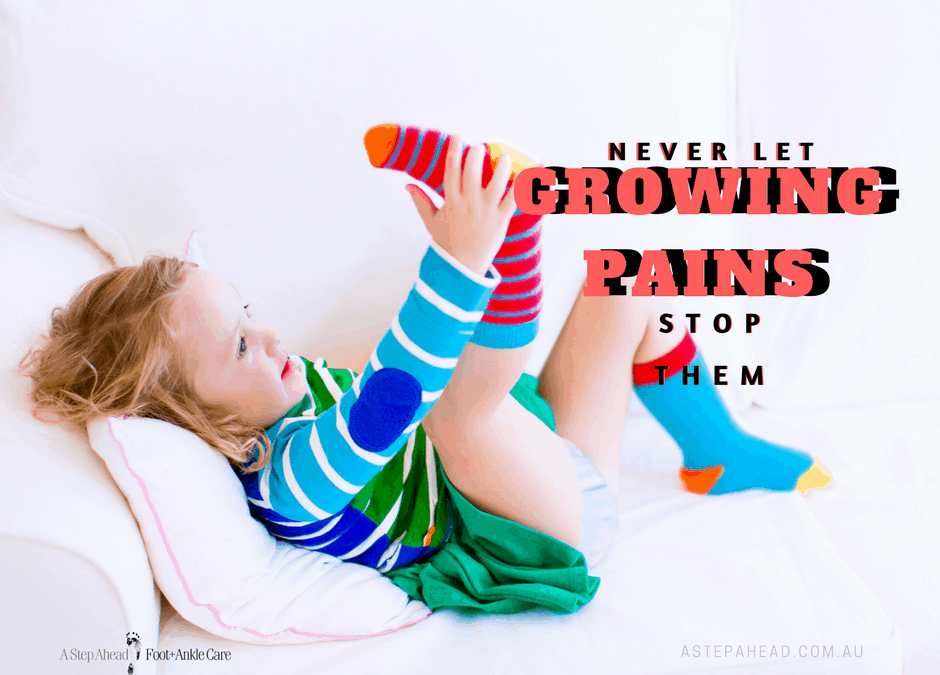
Blog, Kids Feet, Sports Care

Tripping, falling, clumsy or Growing pains – Is it really normal?
Is growing really responsible for your little one’s discomfort?
So, your little one is having a tough time and, therefore, so are you! There’s something not quite right but you just can’t put your finger on it.
Perhaps they seem clumsy, or they trip and fall a little more than their friends of the same age. Maybe they don’t want to walk distances. Perhaps it appears they tire out more than the other kids. Sound familiar?
One of the most frustrating things for a parent or carer is having a child that, for no know apparent reason, wakes at night with pain in their feet legs and lower limbs. Often they’ll be in tears with pain. You’ve tried massaging them, or heat packs. You may have tried Panadol and Nurofen.
What you need is answers!
You head to the GP to tell them the things you’ve noticed. Frustratingly you’re told, “they will grow out of it” or…
“it’s growing pains” or…
“All kids get that” or …
“There’s nothing that you can do” or…
“Oh, it’s completely normal”
Whaaaaaat – You scream!!!
Well we don’t think it’s normal and there is something you can do!
All of the above are classic symptoms we see and recognise as signs your child has foot and lower limb posture problems, and this most certainly CAN be treated.

Getting rid of your child’s pain
We see hundreds of kids who present with their parents with very similar complaints each and every year. Frustrated parents with children who are looking for answers.
One of the most rewarding things about being a practitioner is getting these kids back to health, activity and pain free! To do this we start by running through a detailed history. We examine walking, standing and posture.
We will then recommend treatment aimed at stopping the pain and making your child comfortable (and happy!) again. We provide useful suggestions around footwear, prescribe therapies like massage or orthotics alongside possibly stretching and muscle strength exercises – all aimed at kids and designed to be kid friendly!
Results that make you smile!
There is nothing better than seeing a once uncomfortable child who woke at night crying sitting in your office with a big smile! With parents who have equally enormous smiles!
Parents get to see their once-clumsy-child running around without as many grazed knees. Many mums feel relieved that they no longer have to continuously pick up their child or push them endlessly in the pram because they can now walk distances complaint free!
As a clinic we see numerous kids each week, and we LOVE it! There is little greater than knowing you’ve made someone else’s life just a little bit better. It’s quite addictive.
In an age where we find ourselves complaining that our kids need to “get outside and play more” or we’re constantly saying “put your device down” it’s important that we make certain that they have the ability to be active – without pain.
Too many times we have meet frustrated parents and upset kids who come into our office after being told there is nothing they can do only to find they could have been making things better weeks months or even years earlier!

First steps
Is this sounds all too familiar, we’d like to help. Perhaps this is something that a friend or relative may benefit from. If that’s the case we’d love you to share it with them so they can find relief!
A Step Ahead Foot + Ankle Care is based in Western Sydney. We have multiple practitioners with loads of experience treating kids! Its our passion!
If you’d like more information please contact our helpful front desk team. They are brilliant at working through what help you need, guiding you to the appointment that is right for your family, running through costings and then reserving your appointment time. Call us today on +61 2 9673 2987 we look forward to helping.
Have you checked out our page dedicated to kids’ foot problems? Click here for more information.
Got a question? Visit us on instagram #AskDrFoot

Blog, Uncategorized
Dr Brenden’s top school shoe picks for 2014.
Back to school has hit us again, it’s time for kids to head back into the class rooms and not only hit the books but also hit the school yard in their new school shoes!
Kids spend over 30 hours a week in their school shoes and while most of us think of them simply as a school shoe they also, at school, may become a netball shoe, a handball shoe, a soccer boot, a cricket shoe or even a get chased by a bully shoe!! Needless to say it’s essential that these shoes are tough and sturdy to undertake all this work.
As a parent of two kids myself I understand while we all like to make sure we get the best for our kids we also have to think about the money that its cost to send our kids to school and it all adds up. Many parents hope to get a full year out of a pair of shoes for their child so that’s approximately 40+ weeks of school for most kids. Considering a 40 week year for most shoes we have split up the cost to consider how much that school shoe is costing us each week for our kids. So you can get shoes from as little as 75 cents a week up to worth 3.20 a week more expensive but I believe still a reasonable price to pay for keeping your kids healthy and active!
I have reviewed what I think are some of the school shoe picks of 2014. Some are more expensive and others I have looked at with those on a budget in mind. In essence you get what you pay for but we were pleasantly surprised with one or two of the cheaper models.
I have reviews both traditional school shoes and my favourite runner or sneaker style shoe in all black leather so people get an option as I know a lot of kids love these as well.
I have listed these from my favourite down however the bottom shoes are by no means terrible and in fact are in many respects good shoes.
BEST NEWCOMER!
Start-Rite York
- · School-style shoe
- · Unisex
- · Firm heel counter
- · Bends at the toe
- · Doesn’t twist
- · Doesn’t flex at the middle
- · All leather
- · Black lace-up
· Priced at $129.00 about $3.20 a week
Brenden Says: This is a relative new comer to my list I have not reviewed this shoe before and I have been really impressed with its appearance on the market! All the qualities I look for in a shoe and to me looks like a tough all-round school shoe!
BEST OF THE BEST – Brenden’s top 4!
ASCENT – SCHOLAR and APEX 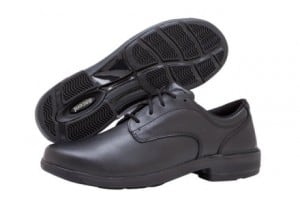
- · Firm heel counter
- · Runner style sole
- · All leather shoe
- · Removable insole for orthotics
- · Bends at toe
- · Doesn’t twist
- · Female / youth
- · Available in 4 widths
From $109.95 (junior size) to $129.95 (adult size) Kids sizes about $2.75 a week
Brenden Says: I have been watching these shoe’s develop and I really feel they are great shoe’s I think Ascent as a brand are developing some excellent quality shoes. Yes I know I am cheating here that this is in fact two shoes but I like these equally and believe they both deserve a mention. I like the School shoe look but the almost sneaker style shoe base. Bends at the toes in all the right places but is strong in the middle and heel where it is needed.
Start-Rite York
- · School-style shoe
- · Unisex
- · Firm heel counter
- · Bends at the toe
- · Doesn’t twist
- · Doesn’t flex at the middle
- · All leather
- · Black lace-up
· Priced at $129.00 about $3.20 a week
Brenden Says: Yes the newcomer makes the top 4! As I said above I think this is a relative new comer has all the qualities I look for in a shoe and to me looks like a tough all-round school shoe! Firm heel counter and solid shank to support kids feet!
CLARKS – 24 SE7EN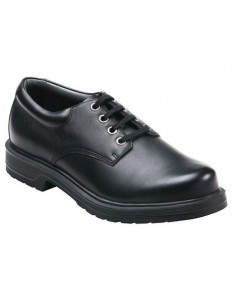
- Firm heel counter
- Runner style sole
- All leather shoe
- Removable insole for orthotics
- Bends at toe
- Doesn’t twist
Priced at $124.95 about $3 a week
Brenden Says: A good shoe that has been doing a good job for kids for a number of years. I think kids will like this shoe it has a chunky see through sole that kids seem to love. It has a firm heel counter that is essential to good footwear. Bends and flex’s in the right spots!
Asics Gel-510TR G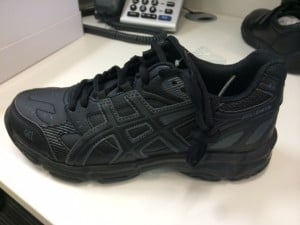
- Firm heel counter
- Bends at the toe
- Doesn’t twist
- Doesn’t flex at the middle
- Running style
- All leather
- Black lace-up
· Price point is RRP of $100 about $2.50 a week
Brenden Says: As a sneaker based shoe this is by far my favourite. I recommend it to any parent looking for a sneaker style school shoe. Its leather based with all the properties of a good quality running shoe. In my experience it seems to last a school year really well which I have noted not all sneaker style running shoes do. A winner for me.
ON A BUDGET. –
GRO-SHU – LEARN
- Firm heel counter
- Removable insole for orthotics
- Bends at toe
- Doesn’t twist
- Leather lined
$39.99 @ Payless Shoes about $1.00 a week!
Brenden Says: This is a good shoe for its price point. While it doesn’t have all the stability I like to see in a school shoe for those on a tight budget at 39.99 I think it out weights others in its class. No you are not getting all the features of the top 4
GROSBY DURABLES – SCHOOL
- Firm heel counter
- Removable insole for orthotics
- Bends at toe
- Doesn’t twist
- Leather upper
$30.00 Big W about 75 cents a week!!!!
Brenden Says: At this tiny price you can afford a few of these a year compared to some of its more heavily priced competitors. In kids small sizes this is a good shoe. It’s not the strongest and it may not last as long as some of the others but at that price you wouldn’t expect it to. As this shoe get bigger in size it loses some of the stability I prefer in the more expensive models but as a Jnr shoe on a budget it’s a good alternative.
Tips when choosing shoes:
- Thumb width’s room between the end of the shoe and the end of the longest to
- The fastening mechanism (lace-up, Velcro or buckle are best!) should hold the heel firmly in the back of the shoe
- The back part of the shoe ‘heel counter’ should be strong and stable
- The shoe should flex across the ball of the foot (not in the middle!)
- The sole should not twist!


























 Dr Brenden’s White paper report on the “6 Reasons You Won’t Beat Heal Pain” outlines what’s stopping you from beating this and tips on how to stop it in its tracks!
Dr Brenden’s White paper report on the “6 Reasons You Won’t Beat Heal Pain” outlines what’s stopping you from beating this and tips on how to stop it in its tracks!